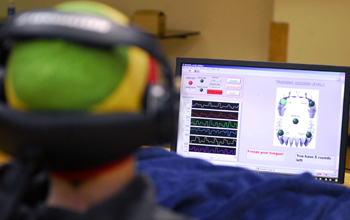Multimedia Gallery
Tongue Drive System to Help Disabled (Image 2)
Cruise Bogle, while participating in a clinical trial for the Tongue Drive system, trains the computer to understand how he will move his tongue to indicate the different commands necessary to operate the powered wheelchair forward, backward, right, left and stop. The Tongue Drive system is an assistive technology that enables individuals to maneuver a powered wheelchair or control a mouse cursor using simple tongue movements.
The clinical trials took place at the Atlanta-based Shepherd Center. Once the computer was ready, Bogle moved his tongue to direct the Tongue Drive system to move the powered wheelchair around an obstacle course. The clinical trials showed that the Tongue Drive system, which was developed by engineers at Georgia Tech, was intuitive and simple for individuals with high-level spinal cord injuries to use.
The research was funded by the National Science Foundation (grant IIS 08-03184) and the Christopher and Dana Reeve Foundation. To learn more, see the GA Tech Research News story Tongue Power: Clinical Trial Shows Quadriplegic Individuals Can Operate Powered Wheelchairs and Computers with Tongue Drive System. (Date of Image: June 2009) [Image 2 of 3 related images. See Image 3.]
Credit: Georgia Tech; photo by Gary Meek
See other images like this on your iPhone or iPad download NSF Science Zone on the Apple App Store.
Images and other media in the National Science Foundation Multimedia Gallery are available for use in print and electronic material by NSF employees, members of the media, university staff, teachers and the general public. All media in the gallery are intended for personal, educational and nonprofit/non-commercial use only.
Images credited to the National Science Foundation, a federal agency, are in the public domain. The images were created by employees of the United States Government as part of their official duties or prepared by contractors as "works for hire" for NSF. You may freely use NSF-credited images and, at your discretion, credit NSF with a "Courtesy: National Science Foundation" notation.
Additional information about general usage can be found in Conditions.
Also Available:
Download the high-resolution JPG version of the image. (2.1 MB)
Use your mouse to right-click (Mac users may need to Ctrl-click) the link above and choose the option that will save the file or target to your computer.



